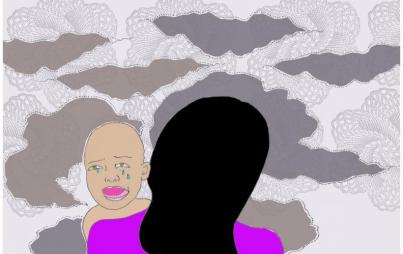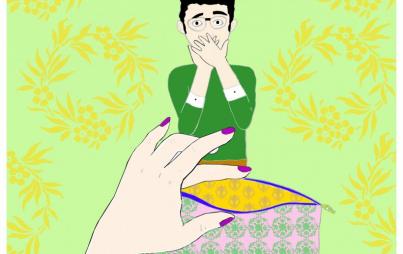
Credit: ThinkStock
It's not a surprise that as a mother, you worry. But the thing no one really tells you is just how much you will worry. Suddenly there is this little person, a human being, who is under your supervision. As in completely in your care. As in you are in charge. Of another person.
You're probably going to panic a bit; that's OK. There are a lot of choices to be made. Feeding. Sleeping. Car seats. You're going to read 672 books—and then you're going to fret anyway.
When my first child was born, I was ready. I was so ready. I read all the books, and I had the bassinet and the cloth diapers and the clothes and the car seat. And then she came. And I was so not ready.
I worried about every detail; the minutiae of the day to day. But more than anything I worried she would just die. That might seem a little . . . dramatic? Morbid? But I assure you the fear of death looms large. Everyone knows someone who knows someone whose baby died. And it's terrifying. Absolutely paralytic.
I'm logical, though, so I did what made the most sense: I just watched her sleep. I quite literally sat poised on the edge of my bed, the low rumble of her father snoring behind me, and watched her breathe. In. Out. In. Out.
There have been hypotheses about the risks babies face. There have been wives tales. And there have been studies. SIDS, Sudden Infant Death Syndrome, has been a parent's source of distress likely for as long as there have been parents, the cloud of worry only lifting after the first year. Clear links have been made to increased SIDS risk, including younger mothers, mothers who smoke, poor prenatal care, overheating and prematurity/low birth weight.
And for just as long as there have been risks, there have been mothers ignoring them . . . and then getting chastised for their presumed lack of concern. According to one recent study, for instance, many mothers are not heeding the recommendation to forgo soft, fluffy bedding, a known SIDS risk factor. Cue the inevitable tsk-tsking.
What kind of mother ignores the advice of professionals? Who overlooks the warnings of reputable studies?
As a mother or five, the mother who spent hours, days even, watching her newborn sleep . . . I am that mother.
Mother Knows Best
At some point it became clear that the "mother sitting on the edge of the bed staring at the baby" method of infant sleep was going to be ineffective. That moment coincidentally coincided with me passing out in a heap of postpartum hormones and exhaustion. In 1995 there wasn't an abundance of information about SIDS. There was just sort of this vague notion that it happened and we should lay our babies on their backs to sleep.
But what I wasn't prepared for, in addition to the laundry list of things I was going to be terrified about, was that my first child, my sweet girl who is now 19, would never. ever. sleep. I would sit up in bed, propped on a mountain of pillows, and nurse her until she fell into what was an apparent deep slumber. I would lay her down so gently, as if she were composed of crystal and china, next to our bed in her bassinet. And she would scream. I would do it again. And she would scream. Ad infinitum.
Eventually I would succumb to my exhaustion and her pleads for my heartbeat, my breath, and I would just put her next to me in bed. She would nurse, all night usually, and I would sleep, waking occasionally to reposition her or switch breasts. Or just look at her, making sure the breathing was still going on. After a few days of this try/fail/put her in my bed routine, I pushed the bassinet into the corner and threw laundry in it.
This all made sense to me. Laying together. Our breathing in sync. Me able to respond to her cries and needs immediately. And every time I woke with a gasp, thinking is she breathing, I could simply open my eyes and see. Because she was right by me.
We shared a bed that way until she was too big for the tiny double bed that her dad and I could barely fit in before she was born. And then, with some difficulty, I moved her to her own room. When the next baby came I skipped the edge of the bed vigil and went straight to snuggling. And the next. And the next. And the next. When my fourth baby was born, in our kitchen (on purpose), we wrapped up and went right to our bed. The three of us snuggled up like a pack, her, her father and me.
My decision to bed-share has always felt right. But it hasn't always been supported by the medical community. Many suggest that the greatest risk to an infant is the possibility of rolling into, or somehow becoming entangled in, something fluffy like pillows and comforters. One British study found that bed-sharing increases the risk of SIDS five-fold. According to the American Academy of Pediatrics, co-sleeping—sleeping in proximity to each other but not in the same bed (such as sharing a room)—is recommended. Bed-sharing is not.
And yet, as with seemingly every parental decision, the "right" approach isn't so clear-cut. There are plenty of experts who tout bed-sharing. Some researchers have even suggested that when all known adverse risk factors are removed—such as a mother who smokes, or a baby sleeping on his tummy—sleep-sharing actually reduces the risk of SIDS.
But the reason I've chosen to sleep in bed with my children has less to do with studies, and more to do with instinct. I analyzed the data for myself, seeing people sleeping with their babies on sofas, while intoxicated, in a recliner, surrounded by 17 blankets and pillows, as the dangers. There was a very real, innate, primal feeling that my children belonged with me, and that I knew what was best for my babies. In addition to making nursing on demand easier—sort of an open bar situation really, with me as the bartender—it worked on a biological level. And I'm not alone in that thinking.
Last night while I drafted this article in my head, my two-and-a-half-year-old son, the "baby," snuggled up beside me, breathing into my chest. He still smells like a baby when he's sleeping, and I breathe him in like oxygen. He's next to me, where he has been, since he was born, in our family "bed" comprised of two beds pushed together. At some point in the night his four-year-old sister will join us too, making the family bed feel a bit more like the family sardine can.
We will (usually) welcome her to bed, regardless of how tight the fit is. The four of us will sleep together until the sun breaks and then we will do it again and again, until the bed is too small, or the babies are too big.







